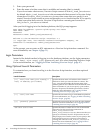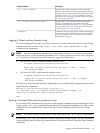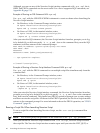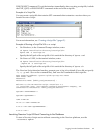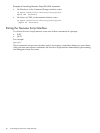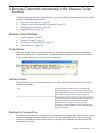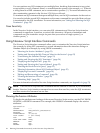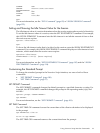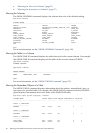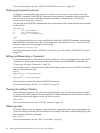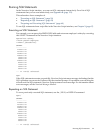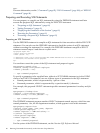20:32:26 SQL ENTER>set time off
SQL ENTER>
For more information, see the “SET TIME Command” (page 112).
Setting and Showing the SQL Terminator
The SQL terminator symbolizes the end of an SQL statement. By default, the SQL terminator is
a semicolon (;).
To change the SQL terminator, enter the SET SQLTERMINATOR command. For example, this
SET TERMINATOR command sets the SQL terminator to a period (.):
SQL>set sqlterminator .
SQL>insert into sales.custlist
+>(select * from invent.supplier
+>where suppnum=8).
--- 1 row(s) inserted.
SQL>
To show the SQL terminator that is in effect for the session, enter the SHOW SQLTERMINATOR
command. For example, this SHOW TERMINATOR command displays SQLTERMINATOR .,
where the period (.) is the SQL terminator for the session:
SQL>show sqlterminator
SQLTERMINATOR .
SQL>
For more information, see the “SET SQLTERMINATOR Command” (page 112) and the “SHOW
SQLTERMINATOR Command” (page 124).
Displaying the Elapsed Time
By default, Neoview Script does not display the elapsed time of an SQL statement after the
statement executes. To display the elapsed time after each SQL statement executes, enter the SET
TIMING ON command:
SQL>set timing on
SQL>select suppname, street, city, state, postcode
+>from invent.supplier
+>where suppnum=3;
SUPPNAME STREET CITY STATE POSTCODE
----------------- -------------------- -------------- ------------ ----------
HIGH DENSITY INC 7600 EMERSON NEW YORK NEW YORK 10230
--- 1 row(s) selected.
Elapsed :00:00:00.111
SQL>
To prevent the elapsed time from being displayed after each SQL statement executes, enter the
SET TIMING OFF command:
SQL>set timing off
SQL>/
SUPPNAME STREET CITY STATE POSTCODE
----------------- -------------------- -------------- ------------ ----------
HIGH DENSITY INC 7600 EMERSON NEW YORK NEW YORK 10230
--- 1 row(s) selected.
54 Running Commands Interactively in the Neoview Script Interface



